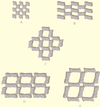Manganese oxide minerals: crystal structures and economic and environmental significance
- PMID: 10097056
- PMCID: PMC34287
- DOI: 10.1073/pnas.96.7.3447
Manganese oxide minerals: crystal structures and economic and environmental significance
Abstract
Manganese oxide minerals have been used for thousands of years-by the ancients for pigments and to clarify glass, and today as ores of Mn metal, catalysts, and battery material. More than 30 Mn oxide minerals occur in a wide variety of geological settings. They are major components of Mn nodules that pave huge areas of the ocean floor and bottoms of many fresh-water lakes. Mn oxide minerals are ubiquitous in soils and sediments and participate in a variety of chemical reactions that affect groundwater and bulk soil composition. Their typical occurrence as fine-grained mixtures makes it difficult to study their atomic structures and crystal chemistries. In recent years, however, investigations using transmission electron microscopy and powder x-ray and neutron diffraction methods have provided important new insights into the structures and properties of these materials. The crystal structures for todorokite and birnessite, two of the more common Mn oxide minerals in terrestrial deposits and ocean nodules, were determined by using powder x-ray diffraction data and the Rietveld refinement method. Because of the large tunnels in todorokite and related structures there is considerable interest in the use of these materials and synthetic analogues as catalysts and cation exchange agents. Birnessite-group minerals have layer structures and readily undergo oxidation reduction and cation-exchange reactions and play a major role in controlling groundwater chemistry.
Figures


References
-
- Turekian K K, Wedepohl K L. Geol Soc Am Bull. 1961;72:175–192.
-
- Crerar D A, Cormick R K, Barnes H L. In: Geology and Geochemistry of Manganese. Varentsov I M, Grasselly Gy, editors. Vol. 1. Stuttgart: E. Schweizerbart’sche Verlagsbuchhandlung; 1980. pp. 293–334.
-
- Varentsov I M. Manganese Ores of Supergene Zone: Geochemistry of Formation. Boston: Kluwer; 1996.
-
- Roy S. In: Manganese Mineralization: Geochemistry and Mineralogy of Terrestrial and Marine Deposits. Nicholson K, Hein J R, Bühn B, Dasgupta S, editors. London: Geological Society; 1997. , Spec. Pub. 119, pp. 5–27.
-
- Lankford W T Jr, Samways N L, Craven R F, McGannon H E, editors. The Making, Shaping, and Treating of Steel. Pittsburgh, PA: Assoc. of Iron and Steel Engineers; 1984.
LinkOut - more resources
Full Text Sources
Other Literature Sources

